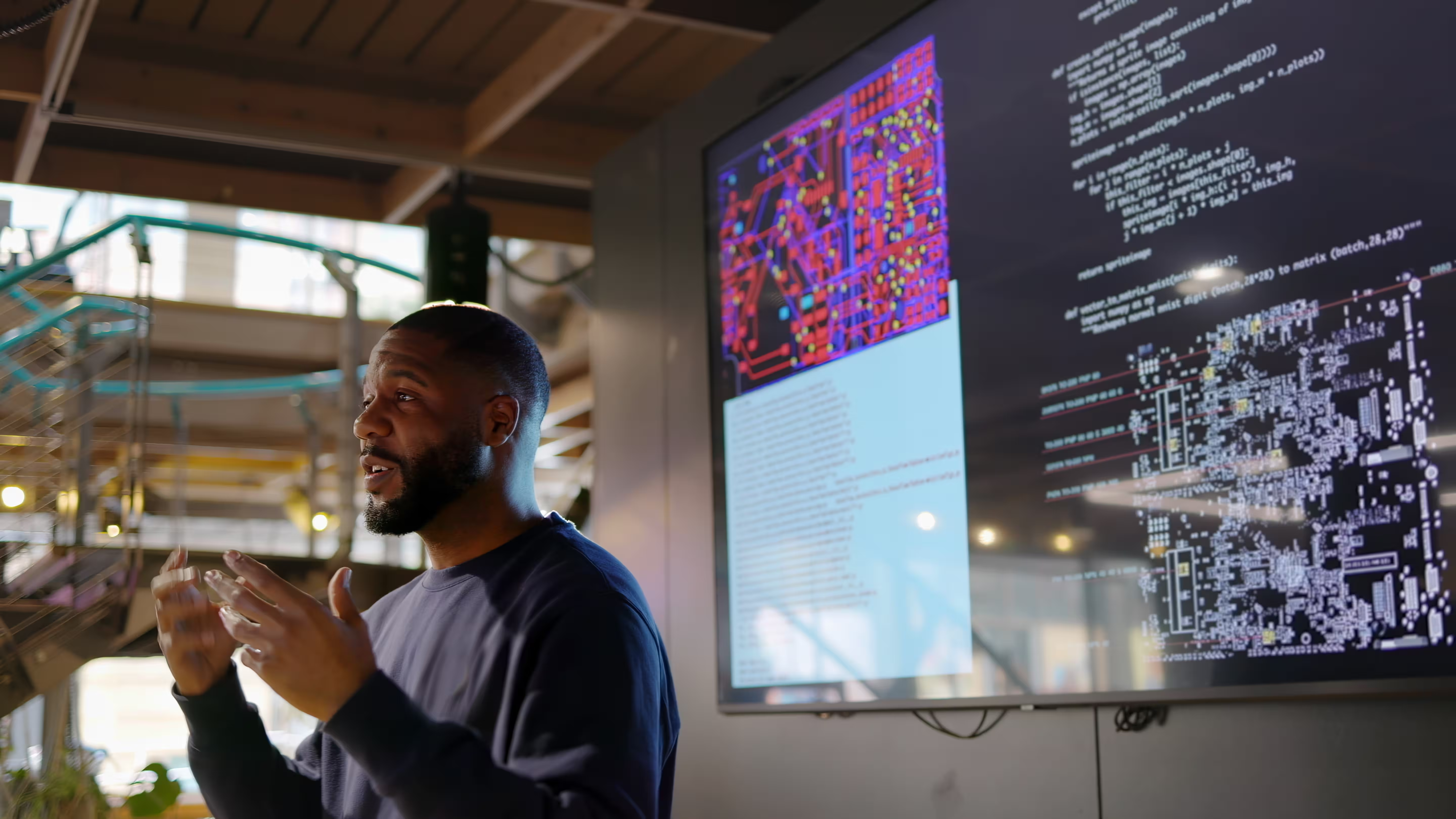If AI in banking is inevitable, the pressing question becomes: What will it look like?
Experts suggest that AI could save banks billions. So it’s no surprise that FIs are highly aware of the potential benefits of AI and machine learning.
Artificial Intelligence (AI) is well on its journey from an innovative concept to mainstream technology, expanding its intelligence to broadly drive operational efficiency. Its benefits are now visible in most industries, including financial institutions (FIs). Here, we explore how AI fits into the banking industry and the potential it has to transform FIs.
The opportunity of AI
AI can revolutionize and disrupt industries quickly. For the banking industry, it brings both opportunities and risks, especially when you consider security and the vital importance of client asset protection.
The power AI holds to disrupt dynamics appears tightly connected to the nature of the information problems it can solve. Financial markets are a multi-dimensional information ecosystem with huge amounts of data and required computing power. Currently, AI’s ability to analyze large amounts of data quickly—known in the industry as summarization—and create algorithmic strategies appears to be outpacing the slower and more methodical analysis that have traditionally led FIs in their long- and short-term investment decisions. That’s because once this data is organized and models are trained to access it, these cycles can access, collate, reorganize and identify the key points at a speed that’s unmatched by other technologies.
According to an article in the Harvard Business Review, these financial trends suggest that an AI-dominated future will rapidly create massive winners and losers. The traditional method of combing over tons of company business models to predict potential growth is now being replaced with AI-led strategies informed by sophisticated algorithms to find opportunities. Both avenues produce information but can have different impacts in terms of stability and efficiency.
Patty Watson, chief information and technology officer at NCR Atleos, explains, “The huge opportunity with AI is its ability to understand huge swathes of data. But one of its challenges is the authenticity of the data. There's a huge opportunity for false information to be used if watchful eyes don’t quality-check the output. The positive thing is that through crawl, walk, run-style approaches, FIs can limit their liability and only implement product models that have piloted successfully.”
Personalization and opportunities through generative AI
Bank of America’s Erica, HDFC Bank’s Eva and TD Bank’s Clari use natural language processing by AI chatbots to help with basic transactions or answer consumer inquiries, such as account balance information. (BizTech)
While AI focuses on the capability to learn from data and make decisions or predictions based on that data, Generative AI (also called gen AI), the next generation in AI innovation, can create something new from the piece of information it is given—text, music, images or even computer code.
Generative AI is enabling companies to embrace human factors engineering: data and principles about human characteristics, capabilities and limitations in relation to machines, jobs and environments. FIs can use sources from existing chatbots or interactions with customer services representatives to create new scripts and enhance the customer experience with gen AI.
Whether it’s feedback your website design (via conversational AI such as voice, chatbot or virtual agent) or product challenges, all that data can be pulled together and used to create models and actionable insights that improve your customer experience. In this way, AI is extremely helpful in personalizing the experience and can be leveraged to increase customer trust and loyalty. AI is also highly proficient in more than 50 languages and can detect and reply in users preferred language.
From powering visualization technologies, such as dashboards, to engaging with users 24/7 via chatbots, AI will be pivotal to creating a unified, personalized experience across banking platforms. Whether in person or online—or even while switching between devices or apps—customers can expect a consistent banking experience.
According to Forbes, financial institutions are using AI and machine learning to predict consumer behavior, understand their purchase preference and even trigger outlier fraud detection alerts to better support card and transaction management.
Increasing productivity
Improving efficiency is a key goal for many businesses. One key benefit of AI is its ability to automate various types of manual and repetitive tasks, freeing up employees to work on more complex and unique challenges. In many cases, human-AI partnerships seem to deliver the best of both worlds. By developing AI processes with human assistance, you mitigate potential risks. Many financial institutions are rethinking their investments in new technology stacks as they consider the speed and agility AI has to offer.
Microsoft estimates that their productivity has increased 35% to 40% since they rolled out generative AI projects.
“Ultimately, AI is all about productivity,” Patti says. “It enables our workforce to complete tasks that would otherwise take them hours, if not days.”
ANZ Bank recently piloted GitHub Copilot, an AI assistant to software engineers, to see how it impacted software engineering. After a six-week trial with 1,000 engineers, the pilot showed a 42% improvement in productivity as well as an increase in code quality, particularly when used by junior engineers.
“AI use can also expand services and fill knowledge gaps moving forward, Patti says. “Consider the variety of coding languages that exist today. In the future, with AI, you might not need to learn all the different languages. Instead, you could use AI to build the program in the coding language needed. But, back to the security issue here: robust rules will be important to ensure that that this code stays within the walls of your operation.”
Security risks and making informed decisions
By leveraging AI, FIs are better equipped to transform the decision-making process to be more accurate, efficient and successful. Many financial institutions make risk, capital allocation and underwriting decisions, based on as little as 10% of the data available to them.
Often, they do so because it’s simply too expensive or too difficult to access the data they need. This is where AI can step in to improve outcomes. And, through AI, organizations have been able to tap into and utilize a previously inaccessible 90% of relevant data, enabling them to now make more informed decisions.
Patty explains her view on future uses of AI: “There are other sectors that aren’t as regulated as FIs and so they have freer rein to explore AI’s potential. But FIs can't operate that way because they are regulated, so they're going to be more guarded and control where they use AI to ensure regulatory compliance. FIs will keep AI and the data it is built upon within their own environments. But there’s clear potential for AI to make a difference in this industry—and it is already doing so. One of the key use cases is the scanning of security logs to monitor what’s happening across the FI’s network.”
Then there’s the ability to use AI to crawl through data to help FIs identify things faster.
“We are exploring the use of AI within our own business walls. These processes will continue to mature and help us improve our service resolution. For example, by using AI to collate and analyze all our servicing data, we are building a model that will benefit our customer engineers out in the field. Now, customer engineers can resolve issues faster by utilizing AI that leverages their colleagues’ previous experiences and findings,” Patty said.
AI in partnership
With the right guardrails, there are benefits for FIs sharing data with partners. For instance, sharing ATM data could further enhance remote monitoring activities, providing the ability to identify problems faster and fix them proactively and remotely. This delivers faster incident resolution and higher uptime because partners have visibility to what's happening on that ATM in real time.
“We’re very close to that future being a reality. We’re working on several pilots that will position us to continue to expand financial access through strengthened customer relationships,” added Patty.
However AI manifests itself for the financial industry, it’s here to stay. AI has the potential to deliver significant impact and improve decision-making through amplified data analysis and delivery of actionable insights. By harnessing its power, service and product offerings will soon set apart the winners and the losers—those that embraced AI and those that didn’t.
Let’s explore what’s possible for your business. Our team is ready to connect and discuss tailored solutions that meet your goals.
Thank you for reaching out. A member of our team will be in touch shortly to continue the conversation.


%20(1).jpg)




%20(1).jpg)





%20(1).jpg)

%20(1).jpg)




%20(1).jpg)
%20(1).jpg)
%20(1).jpg)

%20(1).jpg)
%20(1).jpg)
.jpg)
.jpg)
.jpg)
%20(1).jpg)
.jpg)
.jpg)
.jpg)




.jpg)
.jpg)
.jpg)
.jpg)
